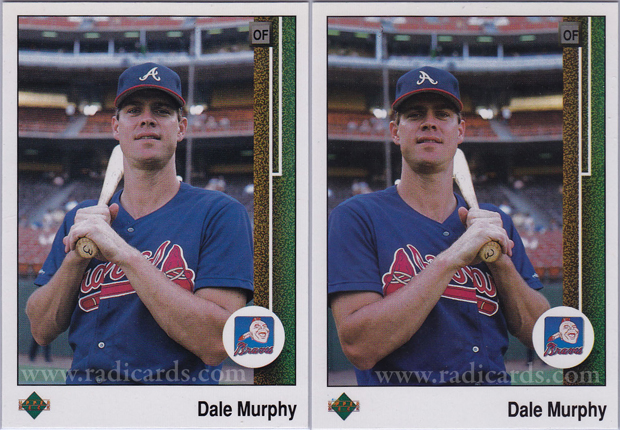
I’ve been meaning to cover this issue for a while now. The Dale Murphy 1989 Upper Deck Reverse Negative is somewhat of a famous error.
1989 was a much needed year for the hobby of card collecting. It was the year that Upper Deck dropped into the market and it changed everything. While Topps, Donruss and Fleer were producing essentially the same thing from 81-88, Upper Deck decided to flip the hobby on its head with high-quality white card stock and the added innovation of the hologram. That’s right, each Upper Deck card came with its own little hologram embedded within it. This helped fight against the frothing affliction of counterfeits that were sprinkled about the hobby during the previous 10 years. While your uncle was in the garage rockin’ Hells Bells and getting his hands dirty playing mechanic with his brand new ’86 Pontiac Firebird, unsuspecting collectors were being duped into buying fake ’86 Donruss Canseco rookie cards. With its holograms, Upper Deck helped fight those dirty fingers and minimize the probability of dishonest manufacturing of the so called, ‘high-end’ card.
But Upper Deck isn’t without its flaws. ’89 Upper Deck is littered with errors and mistakes, as is its ’90 counterpart. From upside down position abbreviations to double prints to over prints, to missing holograms to misplaced holograms, to, and I’ve saved my favorite for last, reverse negatives (RNs). It’s very simple, the picture is flipped horizontally. Sometimes, these RNs are worth a little more due to the notion of proposed lower print runs. This is obvious but isn’t really what intrigues me. What interests me more is the question of intent. Are RNs purposeful “mistakes” to entice buyers and manipulate consumer demand? It’s my sneaky suspicion that they are. If not all of them, then at least some of them. And why not? It can only drive sales and net the company more money. Sure sure, let’s produce an intentional mistake to blow out the bottom line for the fiscal year of ’89, then play it off as if it was genuine. This is the perfect way to enter the market. Right out of the gate, producing some of the most well-known error cards in the hobby to get people talking and buying in search of said error.
Whether or not consumers are building or bashing your company, when your company is the topic of discussion, it helps market your brand. The reason why this is the case is because when we talk, we are actively thinking about what we are saying or hearing. Granted, there’s a lot of hogwash thrown on the table with each occurring discussion but the fact of the matter is is that discussion breads awareness. Since the concept of Marketing is, put bluntly, the contest for the attraction of the consumers attention. The equation here now becomes: discussion = marketing. That said, intentional or not, errors like this get people talking and hence help market your product. In summary, any PR is good PR and regardless of whether or not this was in fact an intentional product doesn’t matter because it did what was ultimately best for Upper Deck in ’89, it helped market the product and drive sales. Errors are exactly the kind of thing that help drive excitement in the card collecting world. For another notable and famous example of seemingly brilliant PR, visit anything ’89 Fleer Bill Ripken.
Shop for the 1989 Upper Deck Dale Murphy

 Visit our store
Visit our store



This is pretty cool, I’d actually never heard of it before this post.
I wouldn’t even buy a Canseco rookie card unless it was graded. Although when one reads enough posts from sportscardsuncensored you start to doubt that slabbed cards are all that legit.
Yea, that’s a tough one but It’s probably a safe bet to protect against the probability of potential fakes.
WHAT is the error on the 1991 Michael Jordan White Sox card
Yo Cheech! I think the Murphy Rev/Neg is a legit mistake. Loading the negative backwards into the enlarger is a real easy thing to do. However, I think the 1990 Donruss JuanGon Rated Rookie #33 Rev/Neg was intentional. I believe Donnruss saw the “chase” for the 89 Fleer Bill Ripkin “F Face”, followed by the 89 UD Murphy Rev/Neg, and hoped lightning would strike a third time.
That’s actually well thought out. I always suspected as much with the iconic ’90 Donruss Juan Gon RevNeg. That’s always been a nice little chase card. If Donruss was smart, they would have printed significantly less of the RevNeg to help maintain integrity and value over time. No matter, I’m still a sucker for stuff like this. 🙂